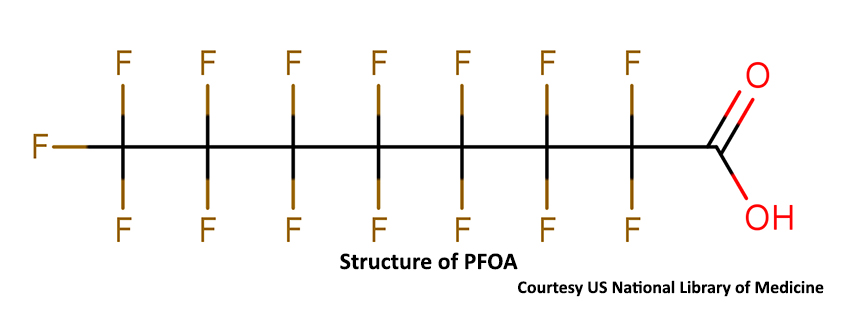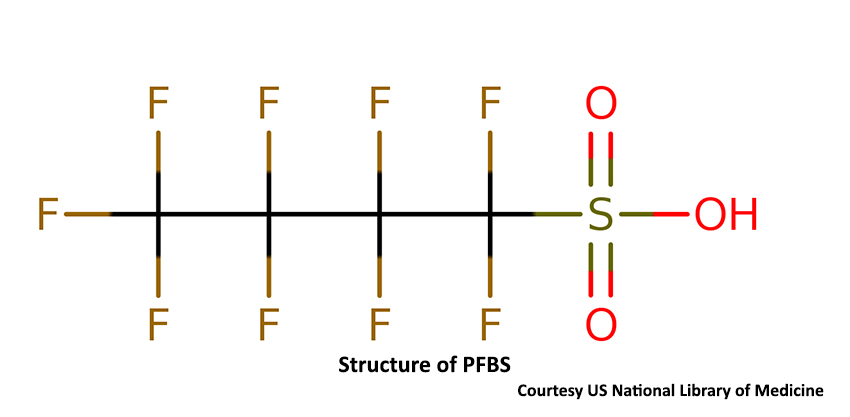President Biden’s 2022 budget request asks for $75 million to “accelerate toxicity studies and research to inform the regulatory development of designating PFAS as hazardous substances.” Remarkably, the Biden Administration has chosen to single out this group of chemicals.
PFAS is the acronym for per- and polyfluoroalkyl substances, a large group of approximately 4,700 chemicals. Their principal use is as processing agents in products that resist heat, oil, stains, grease, and water. They have been used in the production of nonstick cookware, such as Teflon, stain-resistant repellants, such as Scotch-Gard, food packaging materials, and foams used in fire-fighting.
A Bit of Chemistry
The chemicals in this group contain linked chains of carbon and fluorine. The bond between carbon and fluorine is very strong, so these chemicals are helpful in some chemical processes. These chemicals may be divided into two groups:
 1) those with longer carbon-fluorine chains, such as perfluorooctanoic acid (PFOA), which take a very long time to degrade in the environment and the human body:
1) those with longer carbon-fluorine chains, such as perfluorooctanoic acid (PFOA), which take a very long time to degrade in the environment and the human body:
2) those with shorter carbon-fluorine chains, such as perfluorobutane sulfonic acid (PFBS), which degrade much faster:
A Bit of History
In 2001, a class-action lawsuit was filed by some Ohio and West Virginia residents whose drinking water was contaminated with PFOA from a DuPont facility. In making Teflon, PFOAs had been released to the environment and were found in drinking water around the plant. It is important to note that PFOA is not in Teflon itself; it was only used in the manufacturing process.
In 2003, the Environmental Working Group (EWG) petitioned the EPA to investigate evidence that DuPont had withheld studies that showed PFOA caused a “substantial risk of injury to health or the environment.”
Stories began to appear in the media saying that Teflon was not safe, indicating that it could cause cancer and other diseases. People everywhere threw out their nonstick pans. It didn’t matter that PFOA is not actually in Teflon – the scary stories were out there and would not go away.
In 2005, while not admitting guilt, DuPont agreed to pay $10.25 million in civil fines and fund $6.25 million in research projects to settle allegations that it failed to report environmental contamination. DuPont agreed to and did eliminate all PFOA and PFOA-related chemicals in the manufacturing process and products by 2015.
PFOA in Blood
As part of the DuPont settlement, workers at its plants and members of the plants' surrounding communities were monitored for PFOA in their blood. These studies and others reported that PFOA is present in most people’s blood at an average level of 5 parts per billion (ppb) - a tiny amount. There are several theories as to why it has been found so widely in blood; however, its presence does not mean that it causes any harm to people. Analytical chemistry allows us to measure to the ppb level, and below, we can detect just about any chemical we seek; the reason we have not found many more chemicals is that we haven’t looked for them!
ACSH has written about PFOAs in 2005, 2006, and published a booklet on the subject, “Teflon and Human Health, do the Charges Stick.” Why is this relevant? Because PFOA is a longer-chain PFAS and is the chemical that started it all.
“What began as a miracle of modern chemistry is now a national crisis.” EWG
Over the last ten years or so, various advocacy groups, including the EWG, realized that they had a winning issue with the PFAS chemicals. The EWG is known for its ability to scare people about the dangers of chemicals everywhere. It was not enough to stop the manufacture of one chemical in the group, PFOA; they saw money and influence by claiming that all of the chemicals in this group present an imminent hazard.
The EWG started the push to designate all PFAS’ as “hazardous substances” under CERCLA (the Superfund law), claiming that it would speed up the clean-up of Superfund sites that have these substances. It seems like another attempt to identify the next big litigation target, ignoring the actual science of the chemicals. If you have never heard of PFAS, it is probably because the media and other non-scientists tend to use the scarier term “forever chemicals.” This name was used because they are very resistant to degradation (they do not break down readily in the environment) and take a long time to be eliminated from the body.
What Does the Science Say?
- No risk to people for “non-cancer” effects, such as effects on the liver, kidney, or brain from PFOA exposure.
- Most studies in workers and the general population have not shown a cancer risk from PFOA.
- Two studies in rats reported an increase in liver tumors.
They have also been denigrated as “man-made” chemicals with no important uses. Although one may argue about the importance of nonstick cookware and grease-resistant packaging, it is difficult to say that their use in fire-fighting foams has not saved countless lives over the years.
In searching for replacements for PFOA and PFOA-related chemicals, the industry began using some short-chain PFAS chemicals that degrade faster in the environment and human body, including PFBS. For these chemicals, there is
- No evidence of health effects from exposure to PFBS in humans
- No cancer studies are available
- Minimal effects (decrease in thyroid hormone levels) in studies in rats and mice
Conclusions
Every decade or so, a new chemical or group of chemicals catch the public’s attention based on scary stories in the media. In the past, chemicals have caused harm and presented science-verified risks. PFAS are actually not very toxic and have not caused any real harm. Replacing the longer-chain PFAS with the safer, more degradable shorter-chain PFAS did not stop the campaign against these chemicals. I fear we are about to “throw the baby out with the bathwater” by eliminating the use of these chemicals, including their life-saving use in fire-fighting foams.
EPA Drinking Water Health Advisory for Perfluorooctanoic Acid (PFOA)


